Fraud prevention control is the policies and procedures a business has in place to stop fraud from occurring, saving the business from a very costly situation. In this blog, we discuss how to create an effective fraud prevention control strategy for your business, identifying potential areas of weakness. So what is an example of fraud prevention control?
Fraud prevention control can be improved in your business with the following steps:
- Authorisation – only allow purchases that are authorised and spread the responsibility between team members to avoid a single point of failure.
- Reconciliation – assign bookkeeping responsibilities throughout the team to check procedures are followed correctly.
- Restriction – limit access to bank accounts and cards.
Read on to find out more about fraud prevention control and how it can benefit your business.
What is Fraud Prevention Control for Businesses?
Fraud prevention control is the steps a business puts in place to help prevent fraudulent transactional activity. Fraud can impact both customers and the business itself so it is highly important to be aware of the potential threats and prevention measures.
Businesses must put measures in place to protect themselves from fraud to avoid the potential loss of a lot of time, money and even data. As online crime and fraud is constantly evolving, it can be difficult to keep up with the demand. However, having a fraud prevention control plan in place is a solid place to start. You should review your plan often to provide your business with as much protection as possible.
What Are the Different Types of Fraud?
The different types of fraud you can protect your business against include money laundering, tax evasion, threats to cybersecurity and identity theft. The most common type of fraud is imposter scam where a scammer tries to pose as a trustworthy source in order to steal your information.
How to Create a Fraud Prevention Control Plan?
There are several different steps businesses can take to prevent fraudulent transactions. These include:
Authorisation
Any purchases made for your business should require authorisation from a designated individual within the business. This can include any supplies or materials purchased, payroll and disbursements. Other transactions should be distributed throughout the business to avoid the sole responsibility falling on one person. This adds layers of protection against fraud and designating specific transactions to different people means you can easily see where potential opportunities for fraud lie within your business.
Reconciliation
An individual within the business should be assigned the responsibility of bookkeeping. A different individual should then be responsible for reconciling any transactions made throughout the month. This involves checking the companies’ bank statements to ensure that only recognised, trustworthy and business relevant vendors are receiving payment. This employee should date and initial the statements and create a report that details the results and date of the reconciliation.
Restriction
Restricting access to company bank accounts and payment cards is an essential measure in reducing the risk of fraud both externally and internally. Keep account of exactly who has access and create a clear policy outlining the approved transactional activity. Also, take the time to do your research on any creditors to ensure that the payment information matches up with their business details.
Training
To ensure your employees know the correct procedures to follow, regular training ensures they have all the knowledge they need. Also ensure they know who to turn to in the event of fraudulent activity so incidents are properly reported and handled. This is also a great opportunity to get to know your staff more on a personal level, potentially avoiding insider fraud.
Fraud Prevention Control Advice from NEBRC
It is essential that you put measures in place to protect your business from potential fraudulent activity. We have a list of high quality resources available to help you effectively plan and manage your policies and procedures. If you would like more free advice, please reach out to our team who are happy to help. You can also sign up to our free core membership to keep up to date with the latest cyber security matters and keep your business safe online.

